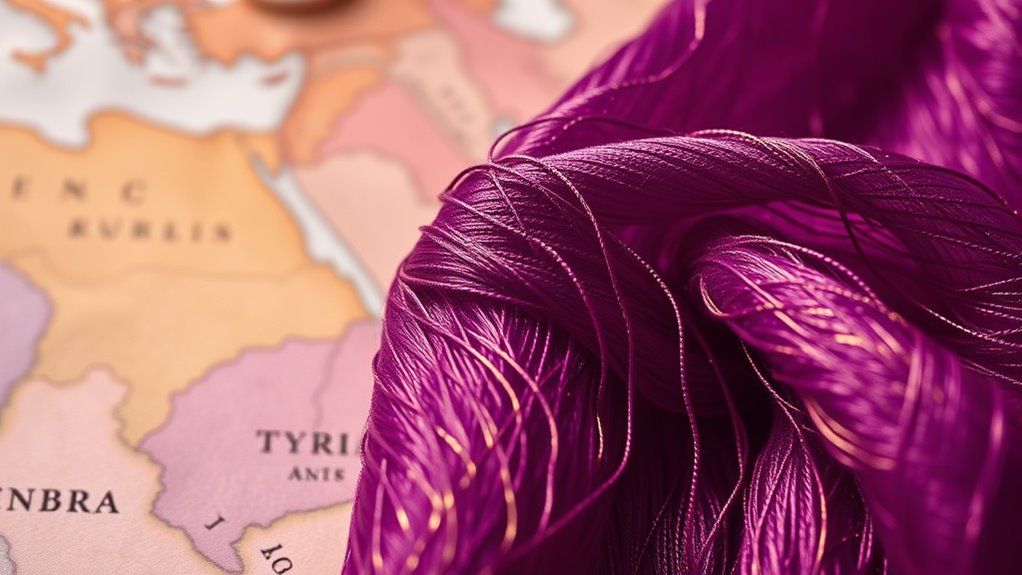Tyrian purple’s rarity and association with royalty fueled ancient trade routes, especially through Phoenician maritime networks. Its production from murex snails was complex and secretive, making it highly valuable. This vibrant color symbolized power, wealth, and divine authority, spreading across civilizations and influencing art, rituals, and social hierarchies. As trade expanded, it boosted regional economies and established powerful maritime empires. To discover how this luxurious dye shaped history and culture, keep exploring these fascinating connections.
Key Takeaways
- Tyrian purple was a highly sought-after dye, driving extensive maritime trade routes across the Mediterranean and beyond.
- Control of murex snail sources and dye production fostered regional dominance and economic power for trading civilizations like Phoenicia.
- Its association with royalty and divine authority motivated states to secure and control key trade networks.
- The dye’s exclusivity stimulated technological innovations in shipbuilding and navigation to expand trade reach.
- Spread of Tyrian purple through trade facilitated cultural exchanges, reinforcing its status as a symbol of power across civilizations.
The Origins of Tyrian Purple and Its Ancient Roots
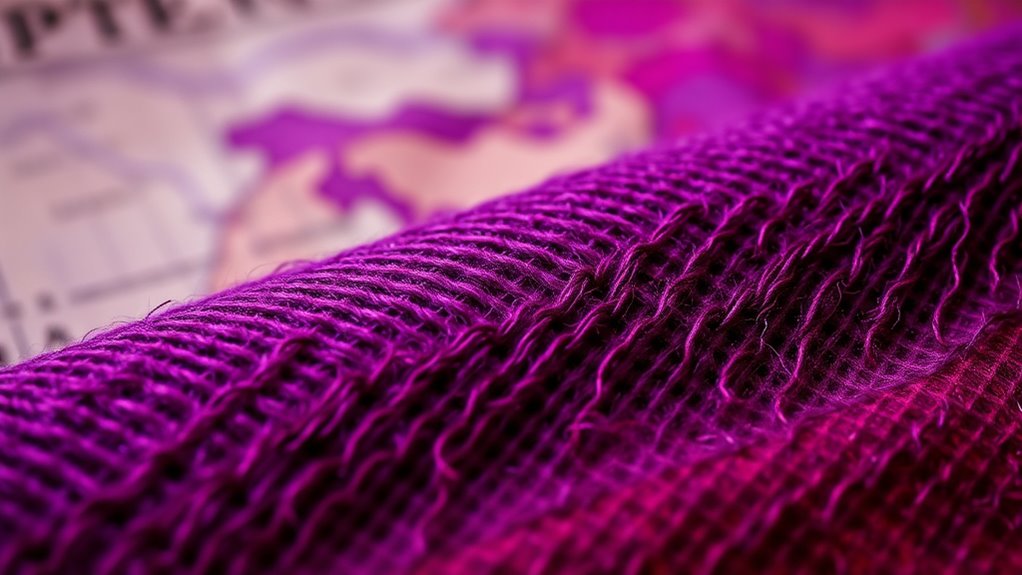
Although Tyrian purple is often associated with luxury, its origins trace back thousands of years to ancient civilizations around the Mediterranean. During ancient dyeing practices, this vibrant hue was crafted from the mucus of the murex snail, making it rare and costly. Its deep, rich color quickly became a symbol of power and prestige. Royalty and elites valued it highly, often wearing garments dyed with Tyrian purple to showcase their status. Its rarity and striking appearance led to its use in royal robes, mosaics, and imperial garments, cementing its role as a symbol of authority. This connection to royalty and exclusivity helped establish Tyrian purple as a color of distinction, shaping social hierarchies and trade routes across ancient civilizations. The process of extracting the dye involved complex dyeing techniques, which contributed to its exclusivity and high value.
The Unique Production Process and Its Secrecy
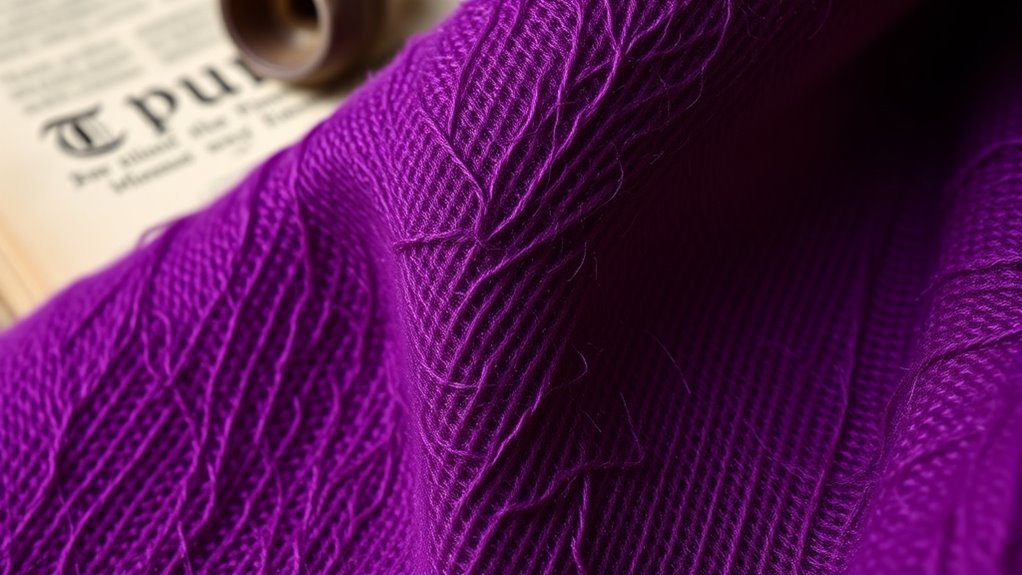
The process of creating Tyrian purple was as intricate as it was secretive, involving a series of specialized steps that only a select few knew. You would start with dyestuff extraction from the mucus of murex sea snails, a painstaking task. Secrecy methods were essential; only trusted artisans handled the process, often in hidden workshops. To produce the vibrant dye, the snail’s mucus was fermented and carefully boiled. The table below highlights key aspects of this process:
| Step | Technique | Secrecy Method |
|---|---|---|
| Dyestuff extraction | Carefully collecting snail mucus | Restricted access |
| Fermentation | Controlled environment | Confidential instructions |
| Dye formation | Precise boiling and mixing | Secret recipes |
| Final dye | Application to fabrics | Limited knowledge sharing |
Symbolism and Status: The Dye’s Role in Society
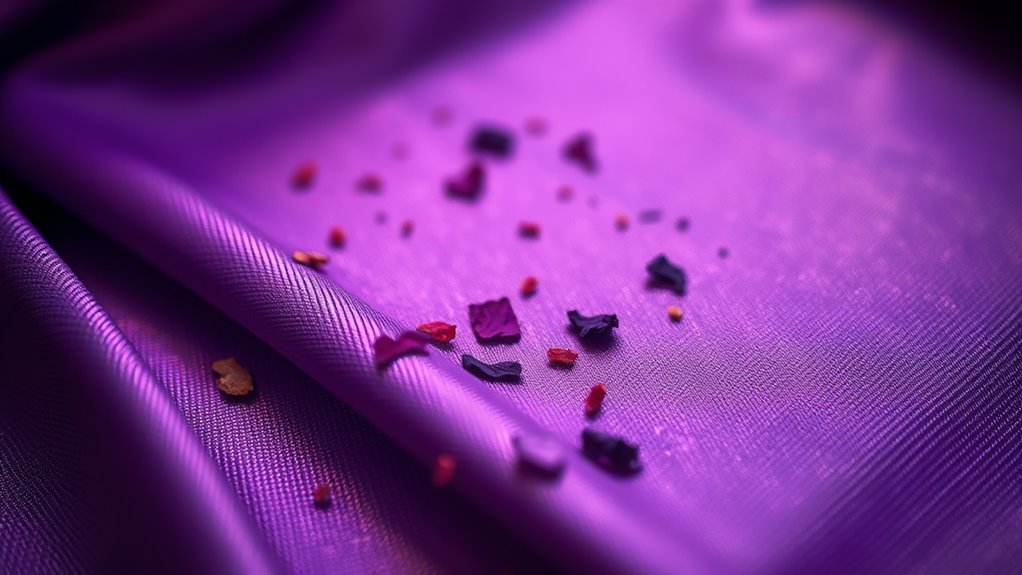
Tyrian purple quickly became a symbol of power and prestige in ancient societies because of its rarity and the difficulty involved in producing it. As a result, it became closely linked to royalty symbolism, signifying authority and divine right. When you see someone wearing this dye, it signals their high social hierarchy and elevated status. The dye’s expensive production made it exclusive to rulers, nobles, and high officials, reinforcing societal ranks. Wearing Tyrian purple wasn’t just about fashion; it conveyed authority, wealth, and legitimacy. Its association with royalty meant that those who donned it were seen as above common citizens, emphasizing the social divide. In this way, the dye played a vital role in societal structure, visually reinforcing distinctions of power and privilege. Additionally, the dye’s complex manufacturing process contributed to its high cost and exclusivity, further cementing its status as a symbol of royal authority.
Trade Networks and the Spread of the Colour

You can see how ancient trade routes transported Tyrian purple across vast regions, connecting different civilizations. These pathways helped spread not just the dye but also its cultural significance and status symbol. As a result, the color’s importance grew, shaping its role in societies far beyond its original Phoenician origins. The trade networks facilitated the dissemination of the dye’s association with royalty and power, further elevating its prestige worldwide.
Ancient Trade Pathways
Ancient trade routes played a essential role in spreading the vibrant purple hue across different civilizations. Marine trade networks connected regions, allowing Tyrian purple to travel far beyond its origins. Phoenician merchants used ships to transport the dye along Mediterranean routes, establishing early trade connections. As textile innovation advanced, artisans incorporated the dye into garments worn by elites, boosting its desirability. The spread of Tyrian purple wasn’t limited to land; maritime trade expanded its reach into Europe, North Africa, and the Middle East. These pathways facilitated cultural exchanges and increased demand for the dye, making it a symbol of power and prestige. Additionally, the affiliate relationships involved in the trade helped promote and sustain the dye’s popularity across regions. Without these ancient trade routes, the rich history and influence of Tyrian purple might have remained confined to its birthplace.
Cultural Color Significance
The extensive trade networks that carried Tyrian purple across regions didn’t just spread a dye; they facilitated the dissemination of its rich cultural significance. As you follow these routes, you’ll see how the color became a symbol of royal authority and divine power, reinforcing status and prestige. Its association with sovereignty meant it was reserved for emperors, kings, and high officials, shaping perceptions of leadership. Beyond royalty, Tyrian purple influenced artistic expression, inspiring painters and craftsmen to embed it in sacred and secular art. Its presence conveyed wealth, authority, and cultural identity. The spread of Tyrian purple through trade didn’t just move a pigment—it carried a powerful message about societal hierarchy and divine right, embedding these ideas into the fabric of ancient civilizations. Trade routes played a crucial role in ensuring that the significance and symbolism of Tyrian purple persisted across different cultures and eras.
Economic Impact and the Rise of Phoenician Maritime Power

The production and trade of Tyrian purple substantially boosted Phoenicia’s economy, transforming it into a maritime powerhouse. Your focus on maritime trade allowed Phoenicia to dominate regional commerce, fueling economic growth. As you expanded your trade routes, you gained access to distant markets, increasing wealth and influence. The table below highlights key benefits of this trade:
| Benefit | Impact |
|---|---|
| Increased Maritime Trade | Expanded trade networks |
| Wealth Accumulation | Funds for city development |
| Political Power | Enhanced influence abroad |
| Technological Innovation | Advanced shipbuilding |
This thriving trade enabled Phoenicia to control vital sea routes, solidifying its position as a dominant maritime power and driving sustained economic growth. Moreover, implementing cybersecurity measures in trade networks became essential to protect valuable data and maintain secure communication channels.
Cultural Significance and Its Influence on Art and Rituals
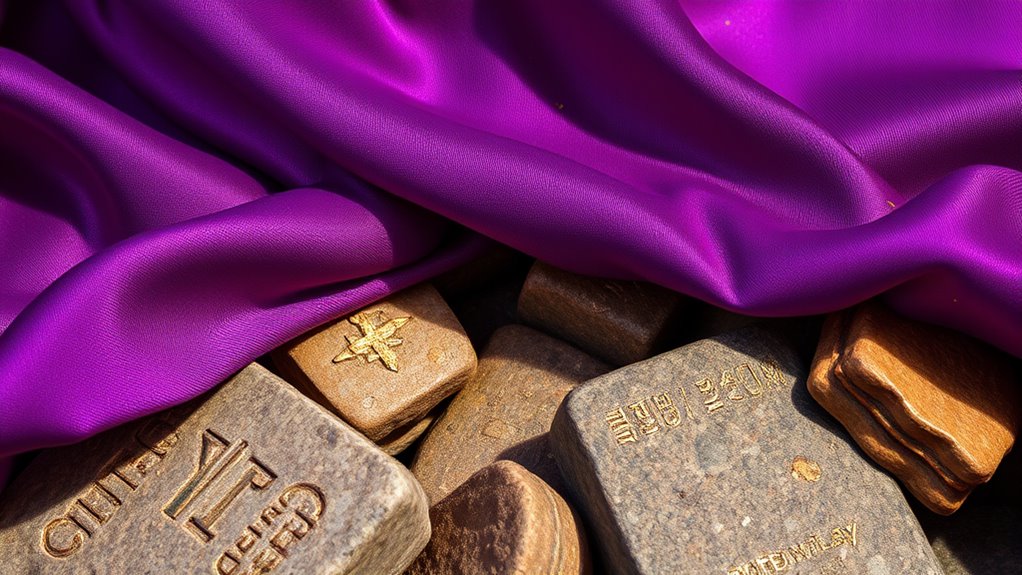
The wealth accumulated through Phoenicia’s maritime trade elevated not just its economy but also its cultural expressions, embedding Tyrian purple deeply into art and rituals. You’ll notice its role in medieval symbolism, where purple signified power and divine authority. In religious symbolism, it represented spiritual purity and kingship. Consider these key influences:
- Royalty’s exclusive use in garments, reaffirming social hierarchy
- Religious ceremonies adorned with purple to evoke divine presence
- Artistic depictions emphasizing divine kingship and heavenly authority
- Rituals where purple signaled sacredness and high status
- The security of eSIM technology, which offers enhanced protection for digital identities linked to such symbols, highlighting ongoing efforts to strengthen cybersecurity protocols.
This color’s prominence reinforced the connection between power, spirituality, and societal structure, shaping perceptions across cultures. Tyrian purple became a visual language, communicating authority and divine favor through art and ritual practices.
The Legacy of Tyrian Purple in Modern Times
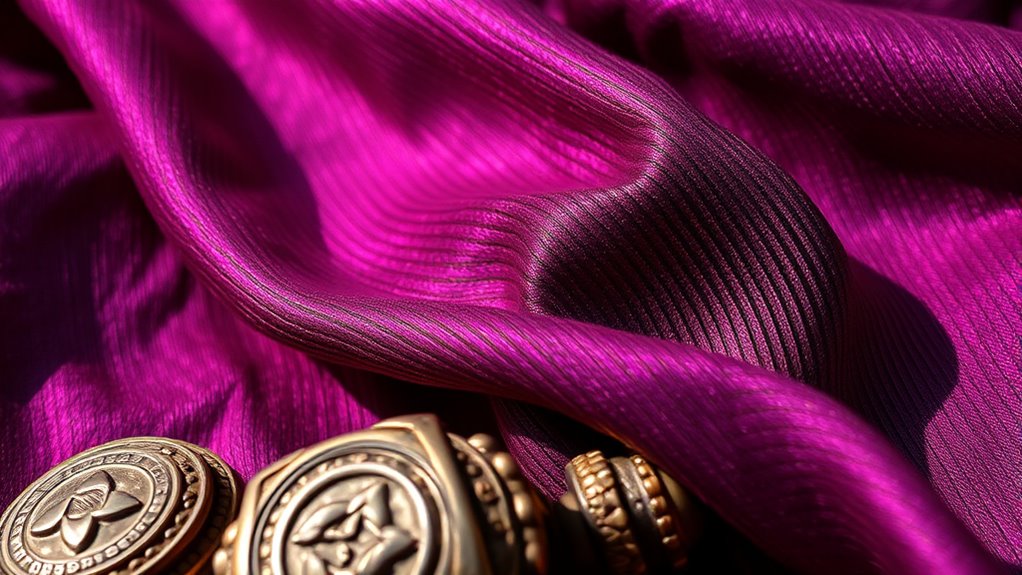
Today, Tyrian purple still influences the fashion industry, often symbolizing luxury and exclusivity. You can see its legacy as a status symbol in modern designs and high-end brands. Advances in dyes and techniques continue to echo its historic rarity and significance. Moreover, the enduring fascination with limited and unique materials in fashion reflects the same appreciation for creative practice that originally made Tyrian purple so coveted.
Fashion Industry Influence
Tyrian purple continues to influence the fashion industry, symbolizing luxury and exclusivity. Its rich history shapes modern textile evolution and reinforces fashion symbolism as a sign of status. Today, designers incorporate shades inspired by Tyrian purple to evoke prestige. Consider these points:
- It remains a symbol of power, often used in high-end collections.
- Its lasting appeal shows how historical significance affects contemporary choices.
- The dye’s rarity drives demand, highlighting the importance of textile innovation.
- Fashion icons frequently choose purple hues to communicate authority and elegance.
This color’s legacy persists, blending ancient symbolism with modern aesthetics. You recognize its prestige in runway trends and luxury brands, demonstrating how Tyrian purple’s historical importance continues to shape fashion’s narrative. The dye’s unique production process and its association with royalty further cement its status as a timeless symbol of opulence.
Symbol of Wealth
Tyrian purple has long stood as a universal symbol of wealth and exclusivity, its rarity making it a coveted marker of affluence. Today, it still influences royal fashion, where wearing this hue signals status and power. Its aesthetic symbolism endures, representing authority and prestige across cultures. Modern designers often draw on its historical legacy, using Tyrian purple to evoke a sense of grandeur and tradition. For those who seek to project success, this color remains a powerful choice. Its association with royalty and wealth continues to resonate, symbolizing achievement and high social standing. The rich history behind its dyeing process demonstrates its rarity and value, reinforcing its status as a symbol of luxury. Whether in fashion, branding, or ceremonial attire, Tyrian purple’s legacy as a symbol of wealth persists, reminding us of its centuries-old connection to power and exclusivity.
Modern Dyes and Techniques
Have you ever wondered how the ancient luxury of Tyrian purple lives on in modern times? Today, natural dyes and advanced textile techniques keep its legacy alive. Modern dyeing uses sustainable, plant-based sources like indigo and madder to recreate rich hues. Here are four key ways this connection persists:
- Natural dyes mimic historic colors, honoring traditional methods.
- Innovative textile techniques enhance dye absorption and longevity.
- Eco-friendly processes reduce environmental impact.
- Fashion designers reintroduce these dyes for luxury, uniqueness, and sustainability.
While synthetic dyes dominate, artisans and researchers emphasize natural dyes to preserve the artistry and cultural significance of ancient textiles. Therefore, Tyrian purple’s legacy continues to influence modern dyes and textile techniques, blending history with innovation.
Frequently Asked Questions
How Did Tyrian Purple Influence Ancient Political Hierarchies?
You see, tyrian purple played a key role in shaping ancient political hierarchies by becoming a symbol of power and authority. When you wear royal attire dyed with this rich color, it signals your high status and political symbolism. This exclusive dye reinforced social distinctions, making rulers and elites easily recognizable. As a result, tyrian purple helped solidify the authority of leaders and emphasized their superior position in society.
Were There Any Other Dyes Rivaling Tyrian Purple’S Prestige?
You might wonder if any dyes rivaled tyrian purple’s prestige. While other dyes like indigo and saffron held value, they didn’t match tyrian purple’s regal symbolism and exclusivity. The dye competition was fierce, but tyrian purple’s association with royalty and power kept it at the top. Its rarity and cost made it a status symbol, solidifying its place as the ultimate dye for the elite.
What Modern Materials Were Inspired by Tyrian Purple’S Chemical Properties?
Think of modern materials as a canvas inspired by ancient paint. Synthetic dyes, developed through advanced chemistry, mimic tyrian purple’s vibrant hue but are far easier to produce. Researchers use dye extraction techniques to create these dyes, making them more accessible and sustainable. These innovations lead to fabrics, inks, and plastics that echo the rich, regal color of tyrian purple, transforming it into everyday materials, rather than a rare royal symbol.
How Did Tyrian Purple Affect the Economy of Ancient Mediterranean Cities?
You see, tyrian purple boosted the economy of ancient Mediterranean cities through its role in maritime trade and luxury markets. As a rare and costly dye, it became a symbol of wealth and power, driving merchants to establish trade routes to source it. This demand elevated the importance of port cities, stimulated commerce, and strengthened economic ties across the region, making tyrian purple a key driver of prosperity in those societies.
Are There Any Current Cultural or Fashion Trends Inspired by Tyrian Purple?
Remember, fashion often repeats itself. Today, you see tyrian purple-inspired trends in royal fashion and modern color symbolism, highlighting elegance and power. Designers incorporate deep, rich hues reminiscent of the ancient dye, making a statement of prestige. These trends reflect how the colour continues to symbolize authority and luxury, proving that what was once reserved for royalty still influences contemporary style and cultural expressions worldwide.
Conclusion
You can see how tyrian purple’s story is like a vibrant thread woven through history, connecting ancient power to modern prestige. Its secretive production and symbolic weight made it more than just a dye — it became a symbol of wealth and authority. Today, its legacy still colors our world, reminding us that even the most elusive shades leave a lasting imprint, like a whisper of royalty that refuses to fade away.
